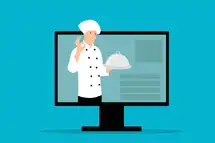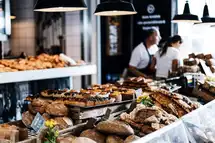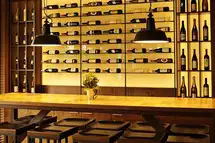How is the changing US economy affecting the restaurant industry?
The changing US economy is having a significant impact on the restaurant industry. To stay competitive and succeed in today's market, restaurants have to be adaptable and proactive in their actions.
The Changing US Economy and the Restaurant Industry
Increased Competition from Other Foodservice Businesses
The restaurant industry has always been known for its competitiveness. Restaurants must continuously find new ways to stand out in a crowded marketplace, offering unique experiences and delicious cuisine to attract diners. However, in recent years, the industry has faced even greater competition from other foodservice businesses, including grocery stores, convenience stores, and delivery services.
Grocery stores have traditionally been a place to purchase ingredients for home-cooked meals, but in recent years, they have expanded their prepared food offerings. Many grocery stores now offer ready-to-eat meals, grab-and-go options, and even full-service cafes. This expansion of grocery store offerings is encroaching on the restaurant industry, as consumers have more options for quick and convenient dining.
Similarly, convenience stores are also entering the restaurant industry with the addition of sit-down dining areas. Previously, convenience stores offered pre-packaged snacks and drinks for on-the-go consumption. Now, many convenience stores have transformed into mini-restaurants, offering hot food items, sandwiches, and even breakfast options. The convenience store industry has recognized the potential in providing dining options for customers who may not have the time or inclination to sit down at a traditional restaurant.
Delivery services have also made it easier than ever to order food from restaurants. With the rise of services such as Uber Eats, GrubHub, and DoorDash, diners have access to a wide range of restaurants from the comfort of their own homes. This ease of access has put pressure on traditional restaurants to compete, especially those that have not yet embraced the digital age and online ordering.
This increased competition is forcing restaurants to re-evaluate their pricing strategies and offer more value to customers. In a market where consumers have many options for dining, restaurants must differentiate themselves by providing unique experiences and high-quality food. By offering competitive prices and a great value, restaurants can better position themselves in the face of increased competition.
In this article, we will discuss how the restaurant industry is being affected by the changing economy. We will emphasize the need for restaurants to adapt to changing consumer preferences and utilize technology to improve efficiency and customer experience, highlight the importance of forming partnerships with other businesses to expand reach and win new customers. By the end of the article, you will have a comprehensive understanding of how exactly restaurants can innovate, stay ahead of the competition, and thrive in the changing economy.
Rising Costs of Food and Labor- A Struggle for the Restaurant Industry

Rising costs of food, labor, and Human Resources are among the biggest challenges for the food industry. Restaurants are feeling the strain, and it's impacting the industry in many ways. One of the major factors contributing to the rising cost of food is the COVID-19 pandemic. The pandemic has disrupted global supply chains, causing shortages and price increases for many food items. In addition, the ongoing war in Ukraine has led to disruptions in the grain market, further driving up the cost of food. Climate change is also impacting food prices, with extreme weather events and droughts leading to crop failures and reduced yields.
The rising Labor Costs is another major challenge for the restaurant industry. The tight labor market means that restaurants are having to compete for a limited pool of workers, driving up wages and benefits. In addition, many states and cities have been raising the minimum wage, which puts additional pressure on restaurant owners to pay their employees more. As a result of these rising costs, restaurants are having to find ways to reduce their expenses.
The Federal Reserve's decisions on interest rates can also have a significant impact on the industry. When interest rates are low, it's easier for businesses to borrow money, which can help them invest in new equipment, expand their operations, or hire more employees. This can be especially beneficial for small businesses, like restaurants, that may not have as much access to capital. On the other hand, when interest rates rise, it becomes more expensive for businesses to borrow money. This can lead to a slowdown in business investment and a reduction in hiring.
The food industry is facing significant challenges when it comes to rising costs of food and labor. The impact of the COVID-19 pandemic, climate change, and other factors are all contributing to these challenges. The Federal Reserve's decisions on interest rates can also have an impact on the industry, making it important for restaurant owners to keep an eye on these developments. Despite these challenges, restaurants that are able to adapt and innovate may still be able to succeed by finding ways to reduce costs, offer competitive prices, and maintain quality and value for their customers.
Fast, User Friendly Time and Attendance Solution
Effortless, Simple, and Swift with Plum Clock
Changing Consumer Preferences
The changing economy is not only affecting the costs and competition within the restaurant industry, but also the preferences of consumers. With the increasing focus on health and wellness, consumers are looking for dining options that are not only delicious but also healthy and affordable. In addition, consumers are seeking convenient dining options that fit their busy lifestyles.
To adapt to these changing preferences, many restaurants are introducing new menu items that feature healthier ingredients and lighter options. For example, some restaurants are offering plant-based or gluten-free options to cater to customers with dietary restrictions or preferences. Other restaurants are also offering take-out or delivery options to provide more convenience for their customers.
However, it is not just about offering healthier and more convenient options. Restaurants that are able to create unique and memorable dining experiences are also thriving. These experiences can range from immersive themes to interactive dining concepts that encourage customer participation.
To stay ahead of the competition, restaurants need to keep up with the changing consumer preferences and adapt their menus and dining experiences accordingly. By providing a variety of options that cater to different dietary preferences and lifestyles, restaurants can attract a wider range of customers and keep them coming back for more.
In short, restaurants that are able to offer healthy, affordable, and convenient options while also providing unique and memorable dining experiences will be the most successful in the face of these changes.
The Need for Innovation and Flexibility
Innovation and flexibility are key for restaurants to succeed in the changing economy of United States. With increased competition, rising costs, and changing consumer preferences, restaurants must be able to adapt quickly in order to stay ahead of the game.
One way that restaurants can innovate is by embracing new Restaurant Technologies. For example, many restaurants are now using mobile apps to allow customers to order and pay for their meals ahead of time, reducing wait times and increasing convenience. Other restaurants are using social media platforms to promote their brand and engage with customers.
Flexibility is also crucial for restaurants in the changing economy. Restaurants need to be able to pivot quickly in response to changes in the economy, such as shifts in consumer preferences or unexpected events like the COVID-19 pandemic. For example, restaurants that were able to quickly adapt to the pandemic by offering takeout and delivery services were better able to weather the storm than those that were slow to adapt.
In addition to technological innovation and flexibility, restaurants can also differentiate themselves by offering unique and memorable dining experiences. This can include everything from creative menu items to interesting decor and ambiance. By offering something that sets them apart from the competition, restaurants can attract new customers and build a loyal following.
The changing US economy presents both challenges and opportunities for the restaurant industry. Restaurants that are able to innovate, stay flexible, and differentiate themselves from the competition will be well-positioned to succeed in the years to come.
The Importance of Customer Service
In the highly competitive restaurant industry, customer service is crucial. With the changing economy and increased competition, restaurants need to prioritize excellent customer service in order to stand out from the crowd. This means more than just providing a friendly greeting and quick service - it means going above and beyond to ensure that customers have a positive experience from start to finish.
One aspect of customer service is being attentive to customer needs. This means not only taking orders accurately and promptly, but also anticipating customer needs and preferences. For example, if a customer has a food allergy, the restaurant should be prepared to offer alternatives or make accommodations. Additionally, staff should be knowledgeable about the menu and able to answer any questions customers may have about ingredients, preparation, or allergens.
Addressing any problems that may arise is another important aspect of good customer service. If a customer has a complaint or issue, it should be taken seriously and addressed promptly. This could involve offering a refund or replacement, or simply apologizing and doing what is necessary to make things right. By addressing problems quickly and professionally, restaurants can show that they value their customers and are committed to providing a positive experience.
In addition to providing excellent customer service, restaurants also need to pay attention to legal requirements and regulations. One important aspect of this is having clear and comprehensive terms of use for their website and any online ordering platforms. These terms should outline the rights reserved and responsibilities of both the restaurant and the customer, as well as any applicable fees, refunds, and cancellation policies.
It is important for restaurants to make sure that customers have a positive overall experience. This means creating a welcoming atmosphere, providing clean and comfortable seating, and offering a range of menu options to suit different tastes and dietary needs. By creating an enjoyable dining experience, restaurants can build customer loyalty and encourage repeat business.
The Power of Technology

There are a number of restaurant and hospitality software solutions available on the market today that can help Small Businesses and medium-sized companies improve their operations and provide a better experience for their customers. Here are five top solutions to consider-
- Hubworks- Hubworks is a comprehensive software solution designed specifically for the restaurant industry. It includes tools for scheduling, time tracking, inventory management, and more. Hubworks can help restaurants streamline their operations, reduce costs, and improve customer satisfaction.
- Toast- Toast is another popular software solution for restaurants. It includes tools for online ordering, payment processing, loyalty programs, and more. Toast can help restaurants increase revenue and improve customer retention.
- OpenTable- OpenTable is a reservation and guest management system that allows restaurants to manage their reservations and guest information from a single platform. It also includes tools for marketing and customer engagement.
- Square- Square is a payment processing and point-of-sale system that can help restaurants streamline their payment processes and improve their customer experience. It includes tools for managing orders, tracking sales, and analyzing customer data.
- Yelp- While not a software solution specifically designed for restaurants, Yelp can be a powerful tool for restaurants looking to increase their visibility and attract new customers. By claiming their business on Yelp and actively managing their profile, restaurants can improve their online reputation and attract new customers.
The Importance of Partnerships
In addition to technology, partnerships can also play a key role in helping restaurants succeed in the changing economy. By partnering with other businesses, restaurants can tap into new markets and customer bases.
One example of a successful partnership is between restaurants and grocery stores. As mentioned earlier, grocery stores are expanding their prepared food offerings, and this presents an opportunity for restaurants to partner with them to offer delivery or pickup services. This can be a win-win situation for both businesses, as the grocery store can offer a wider range of meal options to its customers while the restaurant can expand its reach and customer base.
Restaurants can also partner with other restaurants to offer discounts or promotions. This can be particularly effective for small or medium-sized businesses that may not have the resources to offer large discounts on their own. By teaming up with other restaurants, they can offer more attractive promotions and reach a wider audience.
Another type of partnership that can benefit restaurants is with local tourism organizations. By partnering with these organizations, restaurants can tap into the tourism market and attract visitors to their establishments. This can be especially beneficial for restaurants located in tourist destinations.
Real estate partnerships can also be beneficial for restaurants. For example, a restaurant may choose to partner with a property owner to open a new location. This can be advantageous for both parties, as the property owner can generate additional income from the rent, while the restaurant can expand its operations and increase its revenue.
In addition, real estate partnerships can also help restaurants save on costs. For instance, a restaurant may choose to partner with a real estate developer to build a new location. By partnering with a developer, the restaurant can benefit from their expertise and resources, and may be able to secure more favorable terms for the construction of the new restaurant.
The Future of the Restaurant Industry in the Changing Economy
The changing US economy has had a significant impact on the restaurant industry. Rising costs of food and labor, changing consumer preferences, and the need for innovation and flexibility are just a few of the challenges that restaurants are facing today. However, with these challenges come opportunities for those who are willing to adapt and evolve.
Restaurants that are able to offer healthy, affordable, and convenient dining options will be better positioned to succeed in the changing economy. Consumers are increasingly looking for these types of dining options and restaurants that can meet these needs will be in high demand. Similarly, restaurants that offer unique and memorable dining experiences will also be well-positioned to succeed.
Technology can be a powerful tool for restaurants in improving efficiency, reaching new customers, and providing a better overall experience. By embracing technology, restaurants can stay ahead of the competition and attract more customers.
Collaborating with other businesses can also prove advantageous for restaurants. By forging partnerships with grocery stores or other dining establishments, they can broaden their customer base and enhance their outreach.
In the face of all these challenges, excellent customer service remains paramount. Restaurants that go above and beyond to provide great customer service will be able to keep their customers coming back.
The restaurant industry is constantly evolving, and those who are able to adapt to change will be the ones who thrive in the years to come. While the challenges are many, the opportunities are also plentiful. By staying ahead of the curve and embracing new technologies, dining options, and partnerships, restaurants can continue to be successful in the changing US economy.
Must-Read Content
Frequently Asked Questions
What are some examples of partnerships that restaurants can form with other businesses?
- Menu development or cross-promotional opportunities with local food producers
- Joint marketing and advertising campaigns with businesses in complementary industries (e.g. travel, entertainment, etc.)
- Co-branded loyalty programs with nearby retailers or service providers
- Bulk purchasing arrangements with suppliers
- Shared use of commercial kitchen space or other resources
What are some ways that restaurants can adapt to the changing US economy?
- Offering delivery and takeout services
- Implementing technology solutions like mobile ordering and contactless payment
- Expanding their menu to cater to changing consumer preferences and dietary restrictions
- Prioritizing excellent customer service to build customer loyalty
- Partnering with other businesses and organizations to tap into new markets and customer bases.













































































































